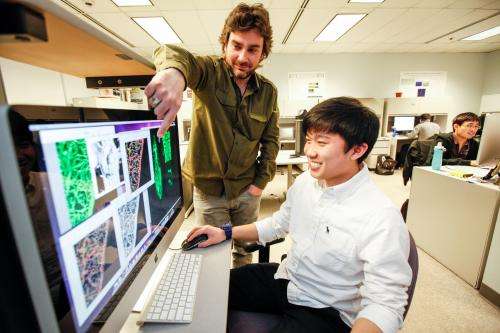Researchers use computers to 'see' neurons to better understand brain function

A study conducted by local high school students and faculty from the Department of Computer and Information Science in the School of Science at Indiana University-Purdue University Indianapolis reveals new information about the motor circuits of the brain that may one day help those developing therapies to treat conditions such as stroke, schizophrenia, spinal cord injury or Alzheimer's disease.
"MRI and CAT scans of the human brain can tell us many things about the structure of this most complicated of organs, formed of trillions of neurons and the synapses via which they communicate. But we are a long way away from having imaging techniques that can show single neurons in a complex brain like the human brain," said Gavriil Tsechpenakis, Ph.D., assistant professor of computer science in the School of Science at IUPUI.
"But using the tools of artificial intelligence, specifically computer vision and image processing, we are able to visualize and process actual neurons of model organisms. Our work in the brain of a model organism—the fruit fly—will help us and other researchers move forward to more complex organisms with the ultimate goal of reconstructing the human central nervous system to gain insight into what goes wrong at the cellular level when devastating disorders of the brain and spinal cord occur. This understanding may ultimately inform the treatment of these conditions," said Tsechpenakis.
In this study, which processed images and reconstructed neuronal motor circuitry in the brain, the researchers, who included two Indianapolis high school students—Rachel Stephens and Tiange (Tony) Qu—collected and analyzed data on minute structures over various developmental stages, efforts linking neuroscience and computer science.
"Both high school students who worked on this study performed neuroscience and computation efforts similar to that conducted elsewhere by graduate students. It was impressive to see what sophisticated and key work they could—with mentoring—do," said Tsechpenakis.
Qu said the work was initially rather scary and intimidating but that he rapidly grew to appreciate the opportunity to work in the School of Science lab. "Unlike high school, we were not told how to get from point A to point B. Dr. Tsechpenakis explained what point A and B were and taught us how to figure out how to get from A to B."
Qu, a 17-year-old senior at Ben Davis High School, now sees neuroscience as a potential college major with biomedical research as an eventual career goal. He continues to work in the lab after school focusing on change over time in fruit fly larvae motor neurons.
Stephens, a senior at North Central High School, said she enjoyed the collaborative nature of the research, with computer scientists and life scientists working together on a problem.
"Dr. Tsechpenakis made it clear to us that different perspectives are necessary, and the ability to think about a problem is more valuable than the education and training you've had," she said. "Before I joined the lab I hadn't really thought about how computer science could help heal." The 17-year-old plans a pre-med major in college and a career as a physician.
















